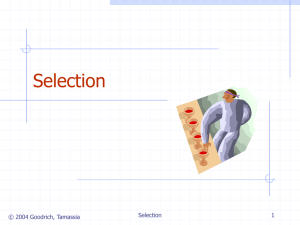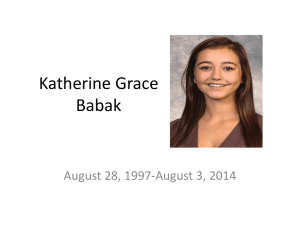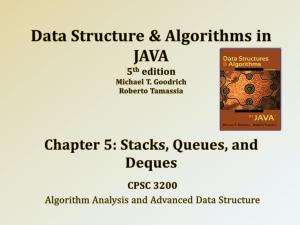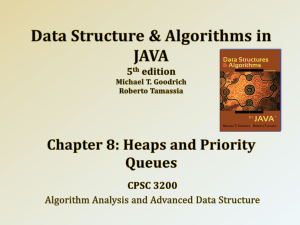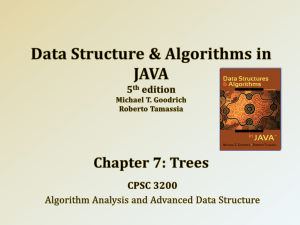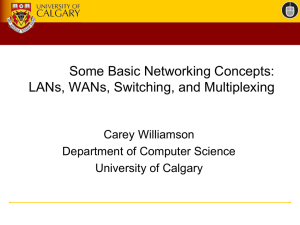n - The University of Tennessee at Chattanooga
advertisement
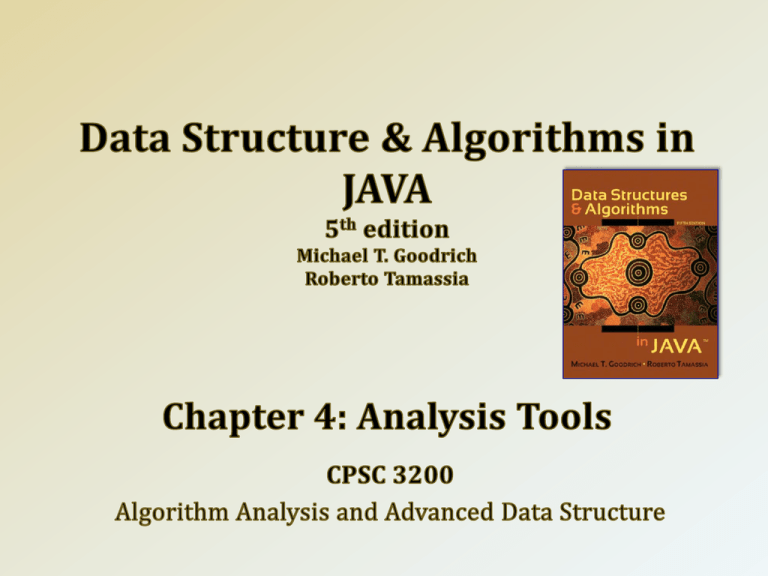
• The Seven Functions.
• Analysis of Algorithms.
• Simple Justification Techniques.
CPSC 3200
University of Tennessee at Chattanooga – Summer 2013
2010 Goodrich, Tamassia
2
• To analyze an algorithm is to determine the amount of
resources (such as time and storage) necessary to execute it.
• Most algorithms are designed to work with inputs of
arbitrary length.
• Usually the efficiency or complexity of an algorithm is
stated as a function relating the input length to the number of
steps (time complexity) or storage locations.
CPSC 3200
University of Tennessee at Chattanooga – Summer 2013
2010 Goodrich, Tamassia
3
• The performance of a computer is determined by:
• The hardware:
• processor used (type and speed).
• memory available (cache and RAM).
• disk available.
• The programming language in which the algorithm is specified.
• The language compiler/interpreter used.
• The computer operating system software.
CPSC 3200
University of Tennessee at Chattanooga – Summer 2013
2010 Goodrich, Tamassia
4
• The amount of computer memory and time needed to run a
program.
• Space complexity
• Why?
• Because We need to know the amount of memory to be
allocated to the program.
• Time complexity
• Why?
• Because We need upper limit on the amount of time needed
by the program. (Real-Time systems)
CPSC 3200
University of Tennessee at Chattanooga – Summer 2013
2010 Goodrich, Tamassia
5
• Space Complexity
• Instruction space (size of the compiled version)
• Data space (constants, variables, arrays, etc.)
• Environment stack space (context switching)
• Time Complexity
• All the factors that space complexity depends on.
• Compilation time
• Execution time
• Operation counts
CPSC 3200
University of Tennessee at Chattanooga – Summer 2013
2010 Goodrich, Tamassia
6
• An algorithm is “a step-by-step procedure for accomplishing
some end.'‘ (solve a problem, complete a task, etc.)
• An algorithm can be given or expressed in many ways.
• For example, it can be written down in English (or French, or any
other “natural'' language).
• We seek algorithms which are correct and efficient.
• Correctness
• For any algorithm, we must prove that it always returns the
desired output for all legal instances of the problem.
• Efficiency: Minimum time and minimum resources.
CPSC 3200
University of Tennessee at Chattanooga – Summer 2013
2010 Goodrich, Tamassia
7
• determine the running time of a program as a function of its
inputs.
• determine the total or maximum memory space needed for
program data.
• determine the total size of the program code.
• determine whether the program correctly computes the desired
result.
• determine the complexity of the program- e.g., how easy is it to
read, understand, and modify.
• determine the robustness of the program- e.g., how well does it
deal with unexpected or erroneous inputs?
• etc.
CPSC 3200
University of Tennessee at Chattanooga – Summer 2013
2010 Goodrich, Tamassia
8
• Seven functions that often appear in algorithm analysis:
• Constant 1
• Logarithmic log n
• Linear n
• N-Log-N n log n
• Quadratic n2
• Cubic n3
• Exponential 2n
CPSC 3200
University of Tennessee at Chattanooga – Summer 2013
2010 Goodrich, Tamassia
9
Slide by Matt Stallmann
included with permission.
g(n) = 1
g(n) = n lg n
g(n) = 2n
g(n) = n2
g(n) = lg n
g(n) = n
CPSC 3200
University of Tennessee at Chattanooga – Summer 2013
g(n) = n3
2010 Goodrich, Tamassia
10
CPSC 3200
University of Tennessee at Chattanooga – Summer 2013
2010 Goodrich, Tamassia
11
CPSC 3200
University of Tennessee at Chattanooga – Summer 2013
2010 Goodrich, Tamassia
12
•
•
•
•
Summations
Logarithms and Exponents
Proof techniques
Basic probability
CPSC 3200
University of Tennessee at Chattanooga – Summer 2013
• properties of logarithms:
logb(xy) = logbx + logby
logb (x/y) = logbx - logby
logbxa = alogbx
logba = logxa/logxb
• properties of exponentials:
a(b+c) = aba c
abc = (ab)c
ab /ac = a(b-c)
b = a logab
bc = a c*logab
2010 Goodrich, Tamassia
13
9000
8000
7000
Time (ms)
• Write a program implementing
the algorithm.
• Run the program with inputs of
varying size and composition.
• Use a method like
System.currentTimeMillis()
to get an accurate measure of
the actual running time.
• Plot the results.
6000
5000
4000
3000
2000
1000
0
0
50
100
Input Size
CPSC 3200
University of Tennessee at Chattanooga – Summer 2013
2010 Goodrich, Tamassia
14
1. It is necessary to implement the algorithm, which may be
difficult.
2. Results may not be indicative of the running time on other
inputs not included in the experiment.
3. In order to compare two algorithms, the same hardware and
software environments must be used.
CPSC 3200
University of Tennessee at Chattanooga – Summer 2013
2010 Goodrich, Tamassia
15
• Uses a high-level description of the algorithm instead of an
implementation.
• Characterizes running time as a function of the input size, n.
• Takes into account all possible inputs.
• Allows us to evaluate the speed of an algorithm independent
of the hardware/software environment.
CPSC 3200
University of Tennessee at Chattanooga – Summer 2013
2010 Goodrich, Tamassia
16
Example: find max
• High-level description of an
element of an array
algorithm.
• More structured than
Algorithm arrayMax(A, n)
English prose.
Input array A of n integers
• Less detailed than a
Output maximum element of A
program.
currentMax A[0]
• Preferred notation for
for i 1 to n 1 do
describing algorithms.
if A[i] currentMax then
• Hides program design
currentMax A[i]
issues.
return currentMax
CPSC 3200
University of Tennessee at Chattanooga – Summer 2013
2010 Goodrich, Tamassia
17
• Control flow
•
•
•
•
•
if … then … [else …]
while … do …
repeat … until …
for … do …
Indentation replaces braces
• Method declaration
Algorithm method (arg [, arg…])
Input …
Output …
CPSC 3200
University of Tennessee at Chattanooga – Summer 2013
• Method call
var.method (arg [, arg…])
• Return value
return expression
• Expressions
Assignment (like in Java)
Equality testing (like in Java)
n2 Superscripts and other
mathematical formatting
allowed
2010 Goodrich, Tamassia
18
• Basic computations performed
by an algorithm.
• Identifiable in pseudocode.
• Largely independent from the
programming language.
• Exact definition not important.
• Assumed to take a constant
amount of time in the RAM
model.
CPSC 3200
University of Tennessee at Chattanooga – Summer 2013
• Examples:
• Evaluating an expression.
• Assigning a value to a
variable.
• Indexing into an array.
• Calling a method.
• Returning from a method.
2010 Goodrich, Tamassia
19
• Most algorithms transform input
objects into output objects.
• Average case time is often
difficult to determine.
• We focus on the worst case
running time.
• Easier to analyze.
• Crucial to applications such as
games, finance and robotics.
CPSC 3200
University of Tennessee at Chattanooga – Summer 2013
120
100
Running Time
• The running time of an algorithm
typically grows with the input
size.
best case
average case
worst case
80
60
40
20
0
1000
2000
3000
4000
Input Size
2010 Goodrich, Tamassia
20
• Given functions f(n) and
g(n), we say that f(n) is
O(g(n)) if there are
positive constants
c and n0 such that
10,000
3n
n
f(n) cg(n) for n n0
100
• Example: 2n + 10 is O(n)
10
•
•
•
•
2n + 10 cn
(c 2) n 10
n 10/(c 2)
Pick c 3 and n0 10
CPSC 3200
University of Tennessee at Chattanooga – Summer 2013
2n+10
1,000
1
1
10
100
1,000
n
2010 Goodrich, Tamassia
21
• Example: the function
n2 is not O(n)
• n2 cn
• nc
• The above inequality
cannot be satisfied since c
must be a constant.
1,000,000
n^2
100n
100,000
10n
n
10,000
1,000
100
10
1
1
10
100
1,000
n
CPSC 3200
University of Tennessee at Chattanooga – Summer 2013
2010 Goodrich, Tamassia
22
• By inspecting the pseudocode, we can determine the
maximum number of primitive operations executed by an
algorithm, as a function of the input size
Algorithm arrayMax(A, n)
currentMax A[0]
for i 1 to n 1 do
if A[i] currentMax then
currentMax A[i]
{ increment counter i }
return currentMax
# operations
2
2n
2(n 1)
2(n 1)
2(n 1)
1
Total
CPSC 3200
University of Tennessee at Chattanooga – Summer 2013
8n 2
2010 Goodrich, Tamassia
23
• Algorithm arrayMax executes 8n 2 primitive
operations in the worst case. Define:
a = Time taken by the fastest primitive operation
b = Time taken by the slowest primitive operation
• Let T(n) be worst-case time of arrayMax. Then
a (8n 2) T(n) b(8n 2)
• Hence, the running time T(n) is bounded by two
linear functions.
CPSC 3200
University of Tennessee at Chattanooga – Summer 2013
2010 Goodrich, Tamassia
24
• If f(n) a polynomial of degree d, then f(n) is
O(nd), i.e.,
1.Drop lower-order terms.
2.Drop constant factors.
• Use the smallest possible class of functions
• Say “2n is O(n)” instead of “2n is O(n2)”
• Use the simplest expression of the class
• Say “3n + 5 is O(n)” instead of “3n + 5 is O(3n)”
CPSC 3200
University of Tennessee at Chattanooga – Summer 2013
2010 Goodrich, Tamassia
25
7n-2
7n-2 is O(n)
need c > 0 and n0 1 such that 7n-2 c•n for n n0
this is true for c = 7 and n0 = 1
3n3 + 20n2 + 5
3n3 + 20n2 + 5 is O(n3)
need c > 0 and n0 1 such that 3n3 + 20n2 + 5 c•n3 for n n0
this is true for c = 4 and n0 = 21
3 log n + 5
3 log n + 5 is O(log n)
need c > 0 and n0 1 such that 3 log n + 5 c•log n for n n0
this is true for c = 8 and n0 = 2
CPSC 3200
University of Tennessee at Chattanooga – Summer 2013
2010 Goodrich, Tamassia
26
• The asymptotic analysis of an algorithm determines the running
time in big-Oh notation.
• To perform the asymptotic analysis
• We find the worst-case number of primitive operations executed as
a function of the input size.
• We express this function with big-Oh notation.
• Example:
• We determine that algorithm arrayMax executes at most 8n 2
primitive operations
• We say that algorithm arrayMax “runs in O(n) time”
• Since constant factors and lower-order terms are eventually
dropped anyhow, we can disregard them when counting
primitive operations.
CPSC 3200
University of Tennessee at Chattanooga – Summer 2013
2010 Goodrich, Tamassia
27
• The big-Oh notation gives an upper bound on the growth
rate of a function.
• The statement “f(n) is O(g(n))” means that the growth
rate of f(n) is no more than the growth rate of g(n)
• We can use the big-Oh notation to rank functions
according to their growth rate.
g(n) grows more
f(n) grows more
Same growth
CPSC 3200
University of Tennessee at Chattanooga – Summer 2013
f(n) is O(g(n))
g(n) is O(f(n))
Yes
No
Yes
No
Yes
Yes
2010 Goodrich, Tamassia
28
CPSC 3200
University of Tennessee at Chattanooga – Summer 2013
2010 Goodrich, Tamassia
29
• We further illustrate asymptotic
analysis with two algorithms for
prefix averages.
• The i-th prefix average of an array
X is average of the first (i + 1)
elements of X:
A[i] (X[0] + X[1] + … + X[i])/(i+1)
• Computing the array A of prefix
averages of another array X has
applications to financial analysis.
35
30
X
A
25
20
15
10
5
0
1 2 3 4 5 6 7
CPSC 3200
University of Tennessee at Chattanooga – Summer 2013
2010 Goodrich, Tamassia
30
• The following algorithm computes prefix averages in
quadratic time by applying the definition
Algorithm prefixAverages1(X, n)
Input array X of n integers
Output array A of prefix averages of X
A new array of n integers
for i 0 to n 1 do
s X[0]
for j 1 to i do
s s + X[j]
A[i] s / (i + 1)
return A
CPSC 3200
University of Tennessee at Chattanooga – Summer 2013
2010 Goodrich, Tamassia
31
• The running time of prefixAverages1 is O(1 + 2 + …+ n)
• The sum of the first n integers is n(n + 1) / 2
• There is a simple visual proof of this fact
• Thus, algorithm prefixAverages1 runs in O(n2) time
CPSC 3200
University of Tennessee at Chattanooga – Summer 2013
2010 Goodrich, Tamassia
32
• The following algorithm computes prefix averages in
linear time by keeping a running sum
Algorithm prefixAverages2(X, n)
Input array X of n integers
Output array A of prefix averages of X
A new array of n integers
s0
for i 0 to n 1 do
s s + X[i]
A[i] s / (i + 1)
return A
CPSC 3200
University of Tennessee at Chattanooga – Summer 2013
2010 Goodrich, Tamassia
33
Algorithm Power(x,n):
Input: A number x and integer n ≥ 0
Output: The value xn
if n = 0 then
return 1
if n is odd then
y ← Power(x,(n−1)/2)
return x·y·y
else
y ← Power(x,n/2)
return y·y
CPSC 3200
University of Tennessee at Chattanooga – Summer 2013
O(log n)
2010 Goodrich, Tamassia
34
public static int capacity(int[] arr)
{
return arr.length; // the capacity of an array
is its length
}
O(1)
CPSC 3200
University of Tennessee at Chattanooga – Summer 2013
2010 Goodrich, Tamassia
35
public static int findMax(int[] arr)
{
int max = arr[0]; // start with the first integer in arr
for (int i=1; i < arr.length; i++)
if (max < arr[i])
max = arr[i]; // update the current maximum
return max; // the current maximum is now the
global maximum
}
O(n)
CPSC 3200
University of Tennessee at Chattanooga – Summer 2013
2010 Goodrich, Tamassia
36
1. By Example.
• Counter Example.
• 2i – 1 is prime !!!
2. The “Contra” Attack.
• Contrapositive.
• If ab is even, then a is even, or b is even.
• Contradiction.
• If ab is odd, then a is odd, and b is odd.
3. Induction and Loop Invariants.
CPSC 3200
University of Tennessee at Chattanooga – Summer 2013
2010 Goodrich, Tamassia
37
CPSC 3200
University of Tennessee at Chattanooga – Summer 2013
2010 Goodrich, Tamassia
38
